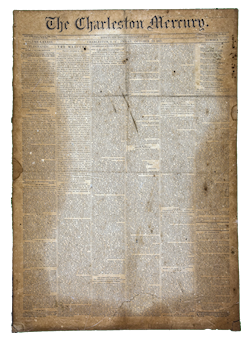April 20, 1863, Charleston Mercury
To the Editor of the Mercury: As the prospect of cultivating the Garden Poppy on an extensive scale is very encouraging, and having received a number of letters asking information relative to the planting, management and preparation of Opium, I send you the following directions, which I have extracted from a work, recently published, entitled “Resources of the Southern Fields and Forests,” by Surgeon F. Peyre Porcher, C. S. Army.
Thomas Lining,
Medical Purveyor, C. S. A.
Garden Poppy.–The variety most preferred is that whose heads or capsules, when ripe, assume a slightly bluish tinge. The color of the flower is unimportant. The seed is either white or black; some persons think that the black seeded variety is more productive, others give the preference to the white in this respect. The structure of the capsules is of more consequence; for there is a variety in which the envelope of the capsule dehises spontaneously when ripe, so that the seed is easily shed; and another, in which the seen remains enclosed within the capsules, which must be opened in order to extract it. The Poppy may become one of the most profitable corps, if we have the means of disposing of the seed, or if we knew how to extract the oil. By proper cultivation it might be made to produce from nine to ten bushels of seed per acre, and one bushel yields twenty-four pounds of good oil.–This oil, especially the first portion, which is cold expressed, and mixed in the mill with slices of apple, is doubtless the purest kind of oil for the table, and the most agreeable that is known. It is inferior to none excepting the finest Nice or Lucca oil. It is preferable to the second rate oil of those places, and the peculiar taste of the olive oil may be imparted to it by the addition of a small quantity of that oil of superior quality.–The oil of the Poppy is bland, and not narcotic. It is used both for food and light, and is considered a fifth more valuable than that of the Coliza. The cakes remaining after the expression of the oil are valuable for the fattening of swine, and the stalks for fuel. The ashes which remains after burning it are of the best kind for manure. The oil expressed in cold weather is much superior to that obtained in warm weather, and the two must not be mixed. The largest seeds, which are employed for medical and domestic use, are obtained from the single-flowered kind, not only for the purpose of extracting Opium, but also on account of the bland esculent oil which is expressed from the seeds, which are simply emulsive, and contain none of the narcotic principle. For the latter purpose, if no other, its culture in this country is worthy of attention. The annual amount of Opium imported into the United States is valued at upwards of $407,000. The Poppy, it is said, produces better when planted in the fall. The seeds should be planted in the month of September, by which means the plants attain sufficient size to endure the cold of winter; they were also found to produce more opium than those planted in March. Having a tap-root, their size will consequently be proportioned to the depth of earth they are enabled to penetrate–hence the necessity of land that will admit of deep ploughing. The finest of the surface, too, is very essential. As the seed is small, and the plants on their first coming up so exceedingly tender, that the brush harrow should always be used after those which are commonly employed. They should be so cultivated that the gatherer may not disturb the plants in collecting the juice. The successful cultivation of the plant, however, requires the provision of a good soil, appropriate manure and careful management. In obtaining Gum Opium, the capsules are cut longitudinally only through the skin, though some advise that it should be done from below upwards. The incisions should be made in the afternoon, the hardened gum being scraped off the next morning. If the incisions be too deep, the juice passes within the poppy head. In England, forty pounds were made in one season by one person.
